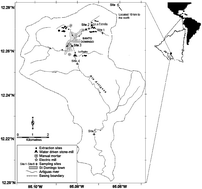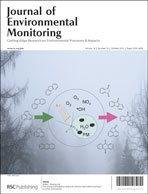We examined the spatial and temporal (hourly) variation of aqueous concentrations of mercury in a gold miner's river to determine factors that control transport, retention, and export of mercury. The mercury flux was estimated to account for episodic inputs of mercury through mining tailings, variations in flow rate, and the partitioning of mercury between dissolved and particulate phases. Water samples were collected upstream and downstream of two gold mining sites in the Artiguas river, Nicaragua. The samples were analyzed for dissolved and suspended mercury, total solids, dissolved organic carbon, and total iron in water. Water velocity was also measured at the sampling sites. We found that mercury was mainly transported in a suspended phase, with a temporal pattern of diurnal peaks corresponding to the amalgamation schedules at the mining plants. The concentrations decreased with distance from the mining sites, suggesting dilution by tributaries or sedimentation of particle-bound mercury. The lowest total mercury concentrations in the water were less than 0.1 μg l−1 and the highest concentration was 5.0 μg l−1. The mercury concentrations are below the present WHO guidelines of 6 μg l−1 but are considered to lead to a higher risk to aquatic bacteria and fish in the stream than to humans. The aqueous concentrations exceed the hazard endpoints for both groups by a probability of about 1%. Particulate mercury accounted for the largest variation of mercury fluxes, whereas dissolved mercury made up most of the long-range transport along the stream. The estimated total mass of mercury retained due to sedimentation of suspended solids was 2.7 kg per year, and the total mass exported downstream from the mining area was 1.6 kg per year. This study demonstrates the importance of the temporal and spatial resolution of observations in describing the occurrence and fate of mercury in a river affected by anthropogenic activities.

You have access to this article
 Please wait while we load your content...
Something went wrong. Try again?
Please wait while we load your content...
Something went wrong. Try again?


 Please wait while we load your content...
Please wait while we load your content...